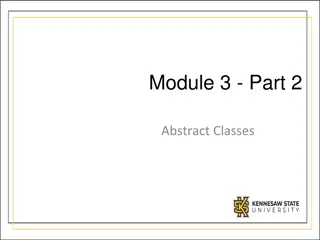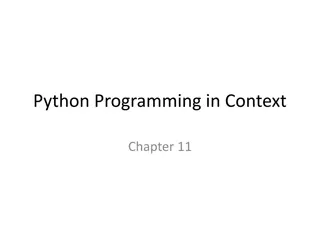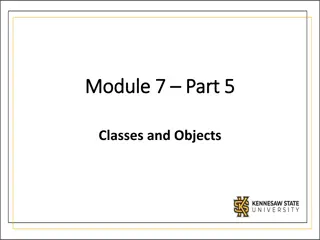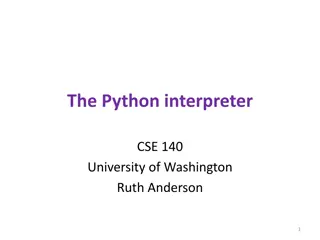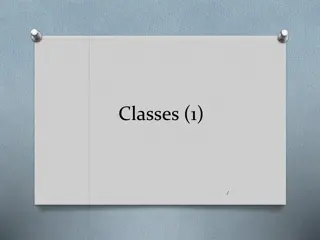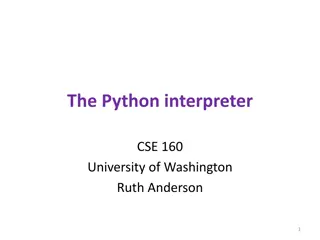Understanding Classes and Objects in Python
An exploration into the principles of object-oriented programming in Python, focusing on classes as factories for creating objects and how objects encapsulate related data and behaviors. Dive into defining classes, creating objects, and working with object methods in Python, with practical examples and explanations.
Uploaded on Sep 10, 2024 | 0 Views
Download Presentation

Please find below an Image/Link to download the presentation.
The content on the website is provided AS IS for your information and personal use only. It may not be sold, licensed, or shared on other websites without obtaining consent from the author. Download presentation by click this link. If you encounter any issues during the download, it is possible that the publisher has removed the file from their server.
E N D
Presentation Transcript
240-216 Explo. CoE Tech. Semester 1, 2025-2026 3. Classes and Objects a class makes objects factory + functions library 1
1. What is an Object? An object groups together all the data related to one thing. e.g. each Person object might contain name and birthday data for a person Person object Person object Person object "Alice" "John" "Bill" 3/2/2002 5/6/2001 2/2/2002 the p1, p2, p3 Person objects 2
2. What is a Class? A class is two things: a factory for making objects a library of functions that objects can use A Car class: factory + functions library makes Car objects 3
Possible Car Objects Car object Car object Car object 2 5 100000 "ferrarri" "porsche" "bean" "red" "green" "yellow" could be lots of other things in a real Car object 4
3.Car Class (car.py) class Car: def __init__(self, dist, type, color): # factory method (constructor) self.dist = dist self.type = type self.color = color def __str__(self): # returns a string version of the object return "(" + str(self.dist) + ", " + self.type + ", " + self.color + ")" will create an object with 3 pieces of data def drive(self, miles): if miles < 0: print("Drive distance cannot be negative") else: self.dist += miles def setType(self, type): if type in ["ferrari", "porsche", "bean", "toyota"]: self.type = type else: print(type, "not supported") class contains 6 functions (including the constructor) def setColor(self, color): self.color = color def getColor(self): return self.color 5
Test Code # create 3 Car objects car1 = Car(2, "ferrari", "red") # uses __init__() car2 = Car(5, "porsche", "green") car3 = Car(10000, "bean", "yellow") car1.drive(100) print("Car1:", car1) # uses __str__() print("Car1's type:", car1.type) print("1. Car1's color:", car1.getColor()) print("2. Car1's color:", car1.color) print() car3.setColor("blue") car3.drive(-9999) print("Car3: ", car3) 6
What is self? selfis the first argument of every function definition tells the function which object's data to use selfis not included when a function is called Instead Python puts the name before the ".": car1.getColor() means call getColor() with car1's data 7
import datetime 4. Person Class class Person(): def __init__(self, name): self.name = name self.birthday = None def __str__(self): return self.name + ": " + str(self.birthday) will create an object with 2 pieces of data def getName(self): return self.name def setBirthday(self, day, month, year): self.birthday = datetime.date(year, month, day) class contains 5 functions (including the constructor) def getAge(self): # returns self's current age in days if self.birthday == None: print("No birthday information") return 0 else: return (datetime.date.today() self.birthday).days 8
Test Code # create two Person objects me = Person("Andrew Davison") print(me) print("My name:", me.getName()) me.setBirthday(23, 7, 1962) print(me) tom = Person("Tom Cruise") tom.setBirthday(3, 7, 1962) print(tom) people = [me, tom] for p in people: print(" ", p, "; today:", p.getAge()) 9
5. Inheritance "a" inherits from "b" when "a" is like "b" but with extra features (and maybe a few changes). "a" is a specialized version of "b" animal inherits mammal insect bear cat dog ant cockroach mosquito 10
6. Inheritance in Python Create a new class by inheriting an existing class no need to start programming from nothing e.g. Studentclass inherits Personclass The Studentclass can add extra data and functions to the ones inherited from Person. 11
Student Inherits Person class Student(Person): def __init__(self, name, id): super().__init__(name) # initialize Person data self.id = id will create an object with 3 pieces of data def __str__(self): return super().__str__() + " (" + str(self.id )+ ")" # return all data def setId(self, id): self.id = id class contains 8 functions (including the 2 constructors) super() means use the function from the inherited class 12
How much data & functions? A Person object has 3 pieces of data: name and birthday inherited from Student id from Person The Person class contains 8 functions: 5 functions inherited from Student 3 functions from Person there are two __init() and __str__() functions use super() to call the inherited ones 13
Test Code # test code s1 = Student('Alice', 10023) s1.setBirthday(5, 6, 2001) Student object s2 = Student('John', 10015) s2.setBirthday(3, 2, 2002) "Alice" s3 = Student('Bill', 10029) s3.setBirthday(2, 2, 2002) 5/6/2001 print(s1) print("Student 2:", s2.name, ",", s2.id) 10023 print() students = [s1,s2,s3] for s in students: print(" ", s, "; today:", s.getAge()) can use name directly can call getAge() 14


